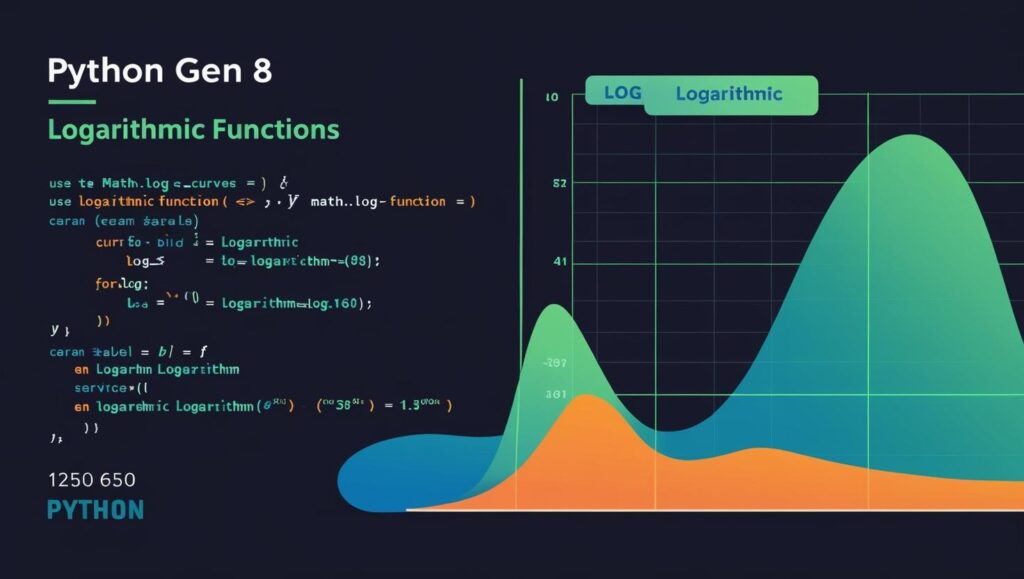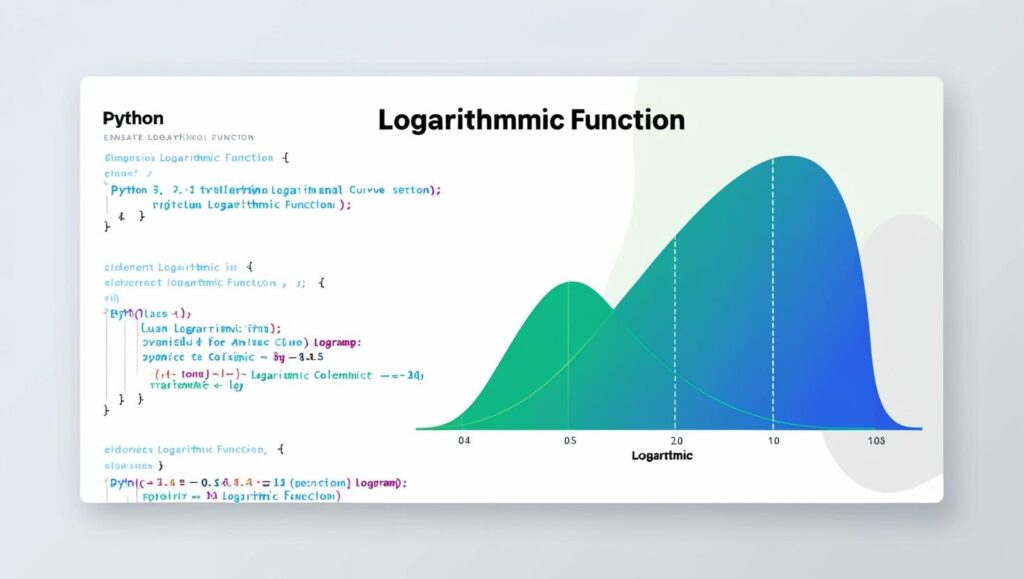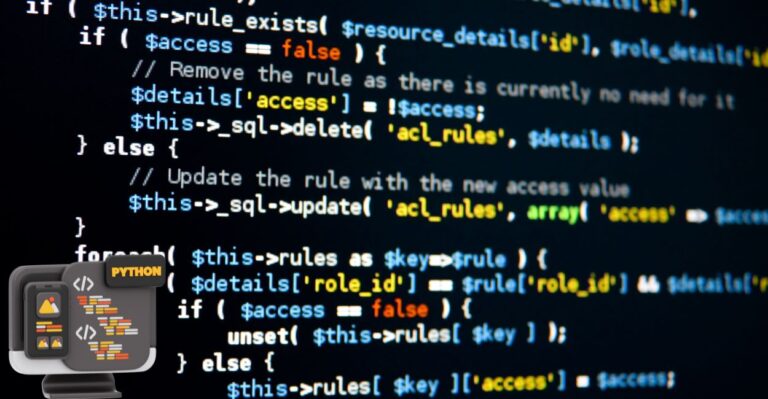A Comprehensive Beginner’s Guide on Logarithmic Python
Logarithmic Python is a powerful concept that helps us solve problems easily. In this article, we will explore logarithms and how they work in Python.
Logarithms may sound complex, but they are quite simple. We will break everything down step by step.
By the end, you will understand logarithms and how to use them in Python.

What is a Logarithm?
A logarithm answers the question: “How many times do we multiply a number to reach another number?”
For example, if we want to know how many times we multiply 2 to get 8, we can use a logarithm. In this case, the answer is 3, because 2×2×2=82 \times 2 \times 2 = 82×2×2=8.
The logarithm of 8 to the base 2 is written as log2(8)=3log_2(8) = 3log28)=3. Here, 2 is the base, and 8 is the number we want to reach.
Why Use Logarithms?
Logarithms are useful in many fields. They help us with calculations in science and finance. Logarithms can make big numbers easier to handle.
For example, instead of writing 1,000,000, we can write log10(1,000,000)log_{10}(1,000,000)log10(1,000,000), which equals 6.
Logarithms also help us understand exponential growth. When something grows quickly, like a population or a bank account, logarithms help us see the growth more clearly.

Read more >>> How to Square in Python
How Do Logarithms Work?
Logarithms have a special relationship with exponents. An exponent tells us how many times to multiply a number by itself. For example, 23=82^3 = 823=8.
In this case, the exponent is 3. To find the logarithm, we ask: “What is the base (2) raised to what power equals 8?” The answer is 3.
This relationship is why logarithms are so helpful. They help us reverse the process of multiplication.
The Different Bases of Logarithms
There are different bases used in logarithms. The most common bases are 10 and e (approximately 2.718).
- Base 10: This is called the common logarithm. We write it as log10log_{10}log10 or simply logloglog.
- Base e: This is called the natural logarithm. We write it as lnlnln.
Each base has its uses. Base 10 is often used in science, while base e is common in finance and natural sciences.
Using Logarithmic Python
Python makes it easy to work with logarithms. The math module includes functions for logarithms. To use logarithms, we first need to import the math module. Here’s how to do it:
import math
Now, we can use the functions to find logarithms. Let’s see some examples.
Example 1: Logarithm with Base 10
To find the logarithm of a number with base 10, we can use math.log10(). Here’s how it works:
import math
number = 1000
log_value = math.log10(number)
print("The logarithm base 10 of", number, "is", log_value)
In this example, we find the logarithm of 1000. The output will be 3, because 103=100010^3 = 1000103=1000.
Read more >>> How to Run Python File in Jenkins
Example 2: Logarithm with Base e
To find the natural logarithm (base e), we use math.log(). Let’s see an example:
import math
number = 20
ln_value = math.log(number)
print("The natural logarithm of", number, "is", ln_value)
This will give us the natural logarithm of 20. The output will show a decimal number.
Example 3: Logarithm with a Custom Base
We can also find logarithms with a custom base using the change of base formula. The formula is:
logb(a)=logk(a)logk(b)log_b(a) = \frac{log_k(a)}{log_k(b)}logb(a)=logk(b)logk(a)
Where:
- aaa is the number we want the logarithm of.
- bbb is the base.
- kkk can be any base (often 10 or e).
Here’s how to do it in Python:
import math
a = 16
b = 4
log_value = math.log(a) / math.log(b)
print("The logarithm of", a, "with base", b, "is", log_value)
This code calculates the logarithm of 16 to the base 4. The output will be 2, because 42=164^2 = 1642=16.

Applications of Logarithms
Logarithms have many real-life applications. Here are a few examples:
- Science: In chemistry, logarithms help us calculate pH levels. A pH of 7 is neutral, while less than 7 is acidic.
- Finance: Logarithms help us understand compound interest. They show how money grows over time.
- Computer Science: Logarithms are important in algorithms. They help us analyze how quickly a program runs.
- Music: In music, logarithms help us understand sound frequencies. The notes we hear are based on logarithmic scales.
Check a reference from w3school.
Read more >>> How to Learn Python Using Easy Methods
Conclusion
Logarithmic Python is a useful tool for solving many problems. We learned what logarithms are and how to use them in Python. By using simple examples, we saw how logarithms work.
Understanding logarithms can help us in school and everyday life. Whether in science, finance, or technology, logarithms are everywhere.
Now that you know how to use them in Python, you can explore even more! Keep practicing, and you will become a logarithm master in no time.






Пытался найти, как не нарваться на шарлатанов — повсюду либо развод, либо ужастики про обманутых заказчиков. Случайно наткнулся на подборку где собраны проверенные ресурсы, где реальные люди делятся опытом. Наконец-то понял, где искать нормальных специалистов
Каталог сайтів
Год искал, где найти хороших мастеров — повсюду либо реклама, или страшилки. Пока не обнаружил на подборку с форумами, с живыми отзывами. Теперь хоть знаю, как выбирать нормальных специалистов
Каталог mydovidnikgospodarya.xyz
Для любителей сыроедения создан специальный раздел. Рецепты без термической обработки, сохраняющие максимум полезных веществ.
titaya.kherson.ua
Для любителей молекулярной кухни создан специальный раздел. Рецепты, адаптированные для домашних условий с доступными ингредиентами.
Кулінарний блог ideidlyanas.net.ua
Терпеть не могу гуглить про строительство! 90% — это либо продвижение товаров, либо устаревшие методики. Пока не наткнулся на базу, где систематизировали исключительно адекватные источники: с реальными кейсами, нормативками и без лишней информации. Наконец-то можно найти нужное быстро
Каталог tvoyakishenka.shop
Монтировал водяной пол — перечитал множество противоречивых рекомендаций. В одних источниках советуют «делайте стяжку 6 см», а в других «хватит и 3 см». В результате нашёл сайт, где систематизировали адекватные материалы: с действующими нормативами, форумами, где реальные строители отвечают и без сомнительных экспертов. Теперь ясно, что делать
Каталог сайтів
Приступая к отделке, был уверен – ведь интернет же, здесь все есть. Ан нет! Один советует наносить три слоя грунтовки, второй – что достаточно одного покрытия, еще один вообще советуют клей ПВА применять. Потратил уйму времени, пока не нашел адекватный список отобранных ресурсов. В нем подобрали исключительно проверенные источники – с нормами, советами практиков и без этой рекламной шелухи. Держите, может убережёте силы
domodomiknash.xyz
Ненавижу гуглить про строительство! Практически все — это либо скрытая реклама, или советы из прошлого века. Пока не обнаружил на каталог, где собрали исключительно адекватные источники: с живыми отзывами, официальными нормативами и без лишней информации. Наконец-то можно найти нужное быстро
Каталог
Ресурс предлагает уникальную функцию – список покупок к каждому рецепту. Можно сразу добавить все необходимые ингредиенты в корзину интернет-магазина или распечатать список.
Рецепти на domolife.icu
Пытался сэкономить на ремонте — повсеместно то “берите только дорогое”, то рекомендации из серии “используйте подручные материалы”. Нашел полезные ресурсы, в которых рассказывают, как действительно можно сэкономить не в ущерб результату
Каталог будівельних сайтів
Выбирал плитку – в каждом магазине мнения расходятся. То “берите только импортную”, то “местный производитель надежнее”. Наткнулся на подборку с сайтами, в которых профессионалы оценивают продукцию без рекламы. Теперь знаю, какую брать
Каталог kostyablog.xyz
Хочу поділитися кулінарною драмою, яка виникла зі мною попереднього тижня. Дочка замовила, аби як мама спекла один неймовірне з нагоди великої події. Я, авжеж, взялася переглядати ідею у кулінарних блогах і – уявіть!. Витратила цілих нервущих одну з половиною години, і це ще щастя!, блукаючи із ресурсу до черговий кулінарний портал! Перші варіанти були занадто для професіоналів, інші варіанти – з екзотичними компонентами, решта – із купою спонсорських посилань. Але потім я згадала про цей порятунок сайт та за п’ять хвилин, і це факт! знайшла – прекрасний рецепт! Інструкція був до безтями простим, що в результаті навіть ще дуже молода юна кулінарка здолала своїй мамі стати справжнім підручним. Як результат ми разом приготували неймовірний десерт, який був визнаний головним хітом свята. Вже сьогодні усі мої вже заздрісні сусідки обсіли мене з розпитуваннями: “На якому сайті я відкрила настільки ідеальний рецепт?”
Каталог
Ненавижу гуглить про строительство! Подавляющее большинство — это или продвижение товаров, или советы из прошлого века. Пока не обнаружил на подборку, где собрали только полезные ресурсы: с реальными кейсами, нормативками и без рекламной шелухи. Теперь экономлю кучу времени
Каталог будівельних сайтів
Вибачте, але я мушу поділитися смішною ситуацією, що сталася з мною того самого тижня, і це було…. Моя принцеса замовила, аби я спекла один святкове на її ДР. Я, звісно ж, безумовно, розпочала вишукувати рецепт в Google і отримала несподіванку. Промучилася цілих нервущих одну з половиною години свого життя, переходячи із блогу у бік черговий кулінарний портал! Перші рецепти здавалися надто для професіоналів, інші – з екзотичними продуктами, ще кілька – з надмірною кількістю банерів. І потім раптово я згадала щодо цей дивовижний портал та за п’ять хвилин вишукала – ідеальний вибір! Ця знахідка виявився настільки покроковим, що навіть юна ще дуже молода помічниця спромоглася своїй мамі стати справжнім підручним. В результаті наш тандем створили ніби з журналу торт, і він став справжнім відкриттям дня народження. Вже сьогодні навіть ті, хто раніше сумнівався мої найкращі сусідки цікавляться: “Де я знайшла цей диво настільки неймовірно класний спосіб?”
Сайт
Завжди вважала, що добре вмію готувати, але останнім часом мої страви стали одноманітними і повторювалися. Подружка порадила мені ознайомитись оригінальні рецепти, але я не знала, з чого почати. Випадково в інтернеті знайшла цей каталог і… це було як відкриття нового світу! Виявилося, що є безліч сайтів з незвичайними рецептами, про які я навіть не підозрювала. Найбільше сподобались категорії з авторськими стравами та рецептами етнічних страв. Протягом місяця я освоїла страву французької гастрономії, тайської та а також іспанської кухні! Моя домочадці в захваті, а я почуваюсь справжнім кухарем. Я навіть почала вести щоденник, де зберігаю цілі кулінарні відкриття, які освоїла
linkinsite.top